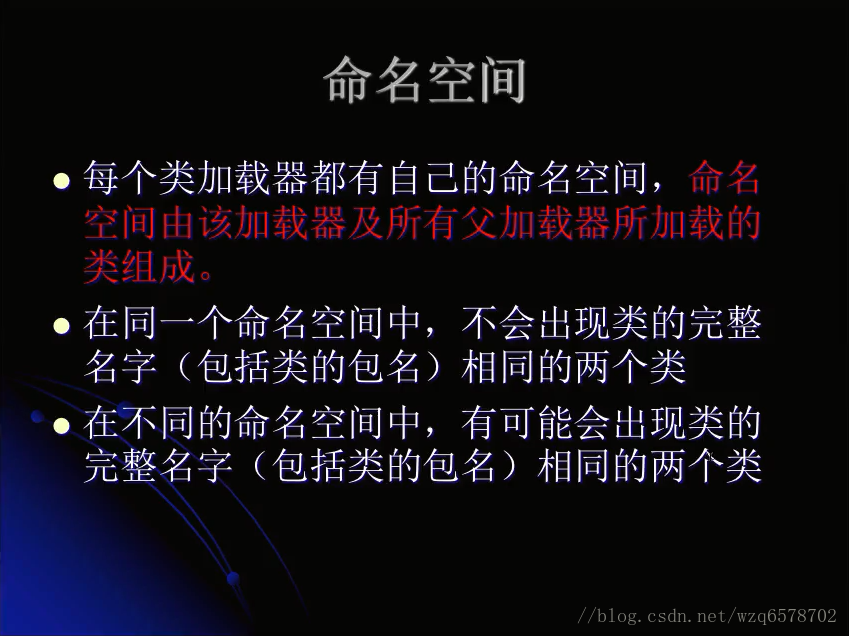我们在之前写过的一个自定义类加载器 :
1 2 3 4 5 6 protected Class<?> findClass(String className) throws ClassNotFoundException { System.out.println("findClass invoked "+className); System.out.println(" this.classLoaderName : "+ this.classLoaderName); byte [] data = loadClassData(className);//中间调用子类的findClass方法 return defineClass(className,data,0,data.length); }
还有test方法我们加一些跟踪打印:
1 2 3 4 5 6 public static void test(ClassLoader classLoader) throws Exception{ Class<?> clazz = classLoader.loadClass("com.twodragonlake.jvm.classloader.MyTest"); Object object = clazz.newInstance(); System.out.println(object.getClass().getClassLoader()); }
然后我们在运行main方法,你会看到findClass的2行并没有打印,并且test方法打印的类加载器是应用类加载器, 也就是意味着我们的自定义类加载器并没有没使用,原因很简单,因为我们的MyTest16构造器:
1 2 3 4 public MyTest16(String classLoaderName){ super();//使用系统类加载器作为当前类的父类委托加载器 this.classLoaderName = classLoaderName; }
使用的父类委托加载器是应用类加载器,我们当前的类“com.twodragonlake.jvm.classloader.MyTest”属于classpath下边,应用类加载可以加载classpath下边的类,所以最终是由应用类加载器加载的。
接下来我们打算加载一个外部的类,我们不把class文件放在当前工程里边,比我放在“E:\data\classes\com\twodragonlake\jvm\classloader.MyTest.class”这里,然后修改程序:
1 2 3 4 5 6 7 8 9 10 11 12 13 14 15 16 17 18 19 20 21 22 23 24 25 26 27 28 29 30 31 32 33 34 35 36 37 38 39 40 41 42 43 44 45 46 47 48 49 50 51 52 53 54 55 56 57 58 59 60 61 62 63 64 65 66 public class MyTest16 extends ClassLoader { private String classLoaderName; private final String fileExtension = ".class"; private String path; public void setPath(String path) { this.path = path; } public MyTest16(String classLoaderName){ super();//使用系统类加载器作为当前类的父类委托加载器 this.classLoaderName = classLoaderName; } public MyTest16(ClassLoader classLoader,String classLoaderName){ super(classLoader);//使用自定义的类加载器作为当前类的父类委托加载器 this.classLoaderName = classLoaderName; } private byte[] loadClassData(String name ){ InputStream inputStream = null; ByteArrayOutputStream baos = null; byte [] bytes = null; try{ //this.classLoaderName = this.classLoaderName.replace(".","\\"); name = name.replace(".","\\");//将包名里边的"."替换为路径分隔符 inputStream = new FileInputStream(new File(this.path + name + this.fileExtension));//文件来自于加载路径path下的包里边的class文件 baos = new ByteArrayOutputStream(); int ch = 0; while (-1 !=(ch = inputStream.read())){ baos.write(ch); } bytes = baos.toByteArray(); }catch (Exception e){ e.printStackTrace(); }finally { try{ inputStream.close(); baos.close(); }catch (Exception e){ e.printStackTrace(); } } return bytes; } @Override protected Class<?> findClass(String className) throws ClassNotFoundException { System.out.println("findClass invoked "+className); System.out.println(" this.classLoaderName : "+ this.classLoaderName); byte [] data = loadClassData(className);//中间调用子类的findClass方法 return defineClass(className,data,0,data.length); } public static void main(String[] args) throws Exception { MyTest16 myClassLoader = new MyTest16("myClassLoader"); myClassLoader.setPath("E:\\data\\classes\\");//设置加载路径 Class<?> clazz = myClassLoader.loadClass("com.twodragonlake.jvm.classloader.MyTest"); System.out.println("class :"+clazz.hashCode()); Object object = clazz.newInstance(); System.out.println(object); } }
打印结果
1 2 3 4 findClass invoked com.twodragonlake.jvm.classloader.MyTest this.classLoaderName : myClassLoader class :21685669 com.twodragonlake.jvm.classloader.MyTest@7f31245a
我们自定义的加载器的findClass 被调用,证明我们写的加载器起了作用。
好,现在我们修改一下main方法,然后保留当前工程里边的MyTest.class文件:
1 2 3 4 5 6 7 8 9 10 11 12 13 14 15 public static void main(String[] args) throws Exception { MyTest16 myClassLoader = new MyTest16("myClassLoader"); myClassLoader.setPath("E:\\data\\classes\\"); Class<?> clazz = myClassLoader.loadClass("com.twodragonlake.jvm.classloader.MyTest"); System.out.println("class :"+clazz.hashCode()); Object object = clazz.newInstance(); System.out.println(object); System.out.println("-----------------------------------------"); MyTest16 myClassLoader1 = new MyTest16("myClassLoader1"); myClassLoader1.setPath("E:\\data\\classes\\"); Class<?> clazza = myClassLoader1.loadClass("com.twodragonlake.jvm.classloader.MyTest"); System.out.println("class :"+clazza.hashCode()); Object objecta = clazza.newInstance(); System.out.println(objecta); }
打印结果:
1 2 3 4 5 class :356573597 com.twodragonlake.jvm.classloader.MyTest@677327b6 ----------------------------------------- class :356573597 com.twodragonlake.jvm.classloader.MyTest@14ae5a5
我们new了2个自定义加载器,结果可以看到使用了系统类加载器加载的,并且第二次加载使用了之前加载出来的结果,这是因为myClassLoader 和myClassLoader1 的父类加载器都是应用类加载器, 这个在之前的loadClass方法的介绍 里边说过,中间会有一个判断是否加载过的方法 ,loadClass会去调用这个判重方法。
之后我们删除当前工程的MyTest.class文件,再去运行这个main方法:
1 2 3 4 5 6 7 8 9 findClass invoked com.twodragonlake.jvm.classloader.MyTest this.classLoaderName : myClassLoader class :21685669 com.twodragonlake.jvm.classloader.MyTest@7f31245a ----------------------------------------- findClass invoked com.twodragonlake.jvm.classloader.MyTest this.classLoaderName : myClassLoader1 class :1173230247 com.twodragonlake.jvm.classloader.MyTest@330bedb4
首先使用了我们自定义的类加载器加载的,并且被加载了2次!!因为类的hashCode编码不同。这两个class(clazz 和clazza )不是同一个class对象,这个和我们之前说过的一个类只能被加载一次是相互矛盾的,这个怎么解释呢,其实是不矛盾的,这里有一个命名空间的问题:
